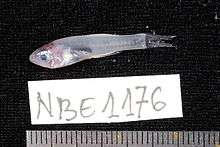Gymnapogon
Gymnapogon is a genus of fish in the family Apogonidae. They are native to the Indo-West Pacific and central Pacific Oceans, where they occur in reefs and nearby habitat types.[2] These species are usually no more than 5 centimeters long and have semitransparent bodies without scales.[2] The genus name is a compound noun formed by combining the Greek gymnos meaning "naked", referring to the lack of scales in the type species, Gymnapogon japonicus, and Apogon, the type genus of the Apogonidae.[3] One species, the B-spot cardinalfish (Gymnapogon urospilotus), is notable for its larvae being rather large, conspicuous and fast-swimming.[4]
| Gymnapogon | |
|---|---|
 | |
| Gymnapogon africanus | |
| Scientific classification | |
| Kingdom: | Animalia |
| Phylum: | Chordata |
| Class: | Actinopterygii |
| Order: | Kurtiformes |
| Family: | Apogonidae |
| Subfamily: | Pseudaminae |
| Genus: | Gymnapogon Regan, 1905 |
| Type species | |
| Gymnapogon japonicus Regan, 1905[1] | |
| Synonyms | |
| |
Species
There are currently 9 recognized species in this genus:[5]
- Gymnapogon africanus J. L. B. Smith, 1954 (Crystal cardinalfish)
- Gymnapogon annona (Whitley, 1936) (Naked cardinalfish)
- Gymnapogon foraminosus (S. Tanaka (I), 1915)
- Gymnapogon janus T. H. Fraser, 2016 [6]
- Gymnapogon japonicus Regan, 1905
- Gymnapogon melanogaster Gon & Golani, 2002
- Gymnapogon philippinus (Herre, 1939) (Philippines cardinalfish)
- Gymnapogon urospilotus Lachner, 1953 (B-spot cardinalfish)
- Gymnapogon vanderbilti (Fowler, 1938) (Vanderbilt's cardinalfish)
gollark: LuaJIT also isn't managing to execute it fast either.
gollark: Even `for i in range(2**32): pass` is slow in Python and I don't know why.
gollark: But this is an esolang, so I doubt it's very efficiently implemented, and this might be doing some sort of inefficient stuff itself.
gollark: I mean, 2^32 is actually within tractable computation range for modern computers (it's 2 billion or so, and my laptop can probably manage 8GIPS (giga-instructions per second) sequentially).
gollark: This is the problem - with ones which are too long they can't be really tested.
References
- Eschmeyer, W. N.; R. Fricke & R. van der Laan (eds.). "Gymnapogon". Catalog of Fishes. California Academy of Sciences. Retrieved 18 September 2018.
- Froese, Rainer and Pauly, Daniel, eds. (2016). Species of Gymnapogon in FishBase. January 2016 version.
- Christopher Scharpf & Kenneth J. Lazara (31 May 2018). "Order KURTIFORMES (Nurseryfishes and Cardinalfishes)". The ETYFish Project Fish Name Etymology Database. Christopher Scharpf and Kenneth J. Lazara. Retrieved 17 September 2018.
- J. S. Nelson; T. C. Grande; M. V. H. Wilson (2016). Fishes of the World (5th ed.). Wiley. p. 752. ISBN 978-1-118-34233-6.
- Mabuchi, K., Fraser, T.H., Song, H., Azuma, Y. & Nishida, M. (2014): Revision of the systematics of the cardinalfishes (Percomorpha: Apogonidae) based on molecular analyses and comparative reevaluation of morphological characters. Zootaxa, 3846 (2): 151–203.
- Fraser, T.H. (2016): A new species of cardinalfish (Gymnapogon, Gymnapogonini, Apogonidae, Percomorpha) from the Philippines. Zootaxa, 4107 (3): 431-438.
This article is issued from Wikipedia. The text is licensed under Creative Commons - Attribution - Sharealike. Additional terms may apply for the media files.